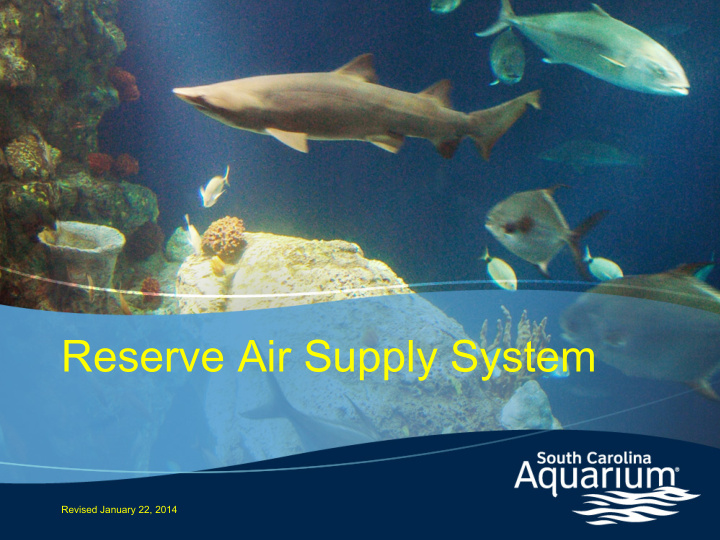



Reserve Air Supply System Revised January 22, 2014
Arnold Postell Senior Biologist / Dive Safety Officer • Work: 579-8536 • Email: apostell@scaquarium.org • Please address any questions regarding the Reserve Air Supply System directly to the DSO.
It is the mission of the South Carolina Aquarium (SCA) Dive Team to provide excellence in animal care and husbandry, to actively support both the educational and conservation endeavors of the SCA, and to provide a memorable, positive guest experience to all those who visit our facility.
Training Schedule • PowerPoint Presentation > Statement of Understanding and Quiz required before in-water use • GOT: 2 dives minimum > Dive One: RASS use > Dive Two: RASS use w/ ascent
Reserve Air Supply System (RASS) • The purpose of redundant reserve air supply systems is to allow the diver a sufficient air supply to safely ascend to the surface in case a diver runs out of air in the primary air source or there is an equipment malfunction. • By definition of redundant this configuration is independent of your primary gas source and has its own air supply, regulator and pressure gauge
Basic Reminders • All Divers must surface with 1000 PSI in their primary air source in the GOT • All divers must surface with 500 PSI in their primary air source in open water • All divers should surface with 500 PSI in their primary air source while on Surface Supplied mode
Dive Planning Depth Volume Pressure Density 0 ’ 1 1 ATM 1 33 ’ 1/2 2 ATM 2 66 ’ 1/3 3 ATM 3 99 ’ 1/4 4 ATM 4 132 ’ 1/5 5 ATM 5 • A scuba tank that lasts 60 minutes on the surface will last 30 minutes at 33 feet. (1/2 volume)
Air Volume of RASS cylinder The volume of air needed will be determined by depth and calculated based on a normal SAC (breathing) rate For Example: 13 cu ft tank 3000 PSI Assent Rate of 30 ’ /minute from 130 ’ At surface cylinder should still have 500psi
RASS Cylinders at the aquarium • Offshore Pony Bottle 13 cu ft. cylinder • GOT Pony Bottle 6 cu ft. cylinder • Surface Supplied Spare Air 1.6 cu ft. cylinder
2 styles • “ Pony Bottle ” (Offshore and GOT) > Traditional looking cylinder, 1 st stage, second stage, and button pressure gauge • Spare Air (Surface Supplied) > Cylinder with 1 st and second stages built into the valve
Pony Bottle Assembly • The traditional pony bottle is assembled just like normal scuba with 1st stage secured to cylinder valve. • Turn cylinder on and check psi 3000 is a “ full cylinder ” • • Turn cylinder off before your dive per commercial regulations Don ’ t depressurize after you • turn cylinder off • The pony cylinder will be clipped to the left side of the BCD as shown in the photo
Pony Attachment
Pony Bottle Use • Turn Cylinder on • Pull second stage free from bungee • Watch orientation of second stage • Purge or exhale into second stage to remove any water **Remember to blow bubbles (do not hold your breath) when swapping regulators
Pony Bottles add weight • Pony bottles add ~ 3 lbs of weight to you and all on the left side. • Divers should consider possibly reducing their normal dive weight use • Divers should also consider rearranging their weights more to the right side to balance the extra 3 lbs from the pony bottle • *Spare Air do not add any significant weight to the diver
Spare Air Assemble • These units are always on- ready for use • Confirm PSI in cylinder > 3000 PSI is a full cylinder Attach the unit to the left side of the diver on the harness as indicated by the arrows in the photo
Spare Air Use • Cylinder is always on • Remove cylinder from carrier pouch • Purge or exhale into second stage to remove any water **Remember to blow bubbles (do not hold your breath) when swapping regulators
Disinfect • Pony bottles and Spare Air are to be disinfected like normal cylinder and regulator guidelines
Filling RASS • Pony bottles are filled • Spare Air systems just like traditional require a special cylinders adaptor. • Use care lowering the cylinder into the fill station *Special hands on instruction is required for filling both types of RASS *Cylinders must have 2500 PSI minimum for a dive
Dive Skills (2 dives required) Dive 1 Pre-dive buddy check Descend to shallow ledge in the exhibit Switch from primary air system to RASS. Switch from RASS back to primary air system Dive 2 Pre-dive buddy check Descend to bottom of the exhibit Switch from primary air system to RASS. Complete a slow ascent on the RASS
Recommend
More recommend